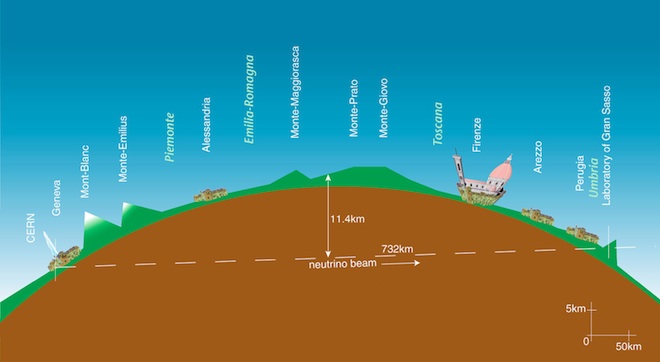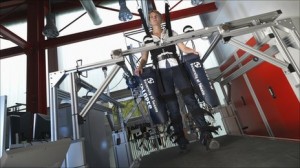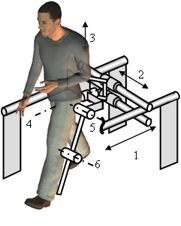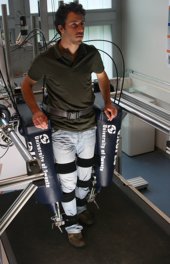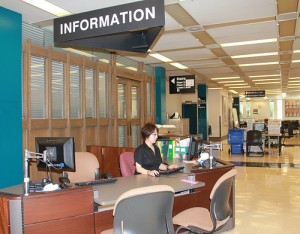On the 23rd of September 160 scientists from the OPERA experiment published a paper online suggesting they have found evidence of neutrinos travelling faster than the speed of light. This announcement has thrown neutrinos and the potential implications of the finding with relation to Einsteins Theory of Relativity into the scientific spotlight.
First of all to provide a little background to the study, neutrinos are tiny subatomic particles each with a “mass of less than a millionth the mass of an electron”. They are uncharged, hence the name neutrino coming from the word neutral, and hardly react with other matter which allows them to pass right through the Earth. Most neutrinos we know of are radiated by our Sun, with 65 billion neutrinos passing through every square centimeter of the Earth perpendicular to the Suns rays every second. They are also hit the Earth from other cosmic rays and are produced as a product of radioactive decay. Scientists can create neutrinos in particle accelerators like the one at the CERN research facility in Geneva, Switzerland (home of the Large Hadron Collider) shown below.
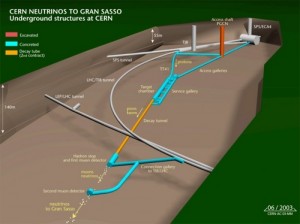
The CNGS (CERN Neutrinos to Gran Sasso) experiment’s main focus is to investigate the phenomenon of how neutrinos ‘oscillate’ (change between the 3 types or flavours of neutrinos (electron, muon and tau neutrinos)) as they travel long distances through matter. Determining the velocity of neutrinos is a secondary aim of the experiment (however after these findings I’m sure it moved up the list of priorities). Muon neutrinos are created in the Super Proton Syncrotron (SPS) particle accelerator at CERN and fired 732km through the Earth to the OPERA (Oscillation Project with Emulsion-tRacking Apparatus) detector in Gran Sasso, Italy. The speed of these neutrinos is calculated using the same basic physics of Speed = Distance / Time that you learned in high school, however with more precision than ever before. The distance between the SPS in Switzerland and the OPERA detector in Italy is known to within 20cm and the timing is measured using GPS timing signals and a cesium atomic clock with the sensitivity of this experiment “roughly an order of magnitude better than previous experiments.” This experimental design is shown below.
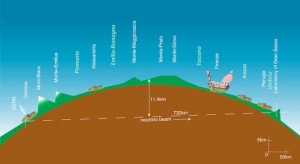
Neutrinos are notoriously hard to detect due to their neglible mass but after 3 years the OPERA experiment has managed to collect 16,000 neutrinos (only 10^-14 % of the neutrinos created!) with some very interesting findings. When comparing the time it took the neutrinos to make the trip to Gran Sasso to how long it would take light, they were shocked to find the neutrinos “arrived at Gran Sasso sixty billionths of a second earlier, with an error margin of plus or minus 10 billionths of a second”. This has led them to publish their findings for the wider scientific community to scrutinise.
This paper has pushed physics into the media spotlight due to the implications this finding could have if it is replicated. If it is proven that the neutrinos are in fact travelling faster than the speed of light (rather than this being the result of some experimental error or statistical miscalculation) then they are breaking one of the fundamental laws of modern physics – that nothing can exceed the speed that light travels at in a vacuum (effectively the speed limit of the universe). This is the foundation of Einsteins Theory of Relativity and a cornerstone of the maths we use to understand and model the universe. Brian Cox, a professor of particle physics at the University of Manchester said, “If you’ve got something travelling faster than light, then it’s the most profound discovery of the last 100 years or more in physics. It’s a very, very big deal. It requires a complete rewriting of our understanding of the universe.”
If neutrinos do in fact travel faster than light then this “raises the troubling possibility of a way to send information back in time, blurring the line between past and present and wreaking havoc with the fundamental principle of cause and effect.” Another explanation being proposed is that the neutrinos are skipping through another dimension on their way to Gran Sasso which also raises a lot of fascinating questions.
However the media should be prepared to wait a long time before this is proven/disproven because theres an important paragraph in the paper published by the OPERA team that hasn’t recieved as much attention (or the media has chosen to ignore).
“Despite the large significance of the measurement reported here and the stability of the analysis, the potential great impact of the results motivates the continuation of our studies in order to investigate possible still unknown systematic effects that could explain the observed anomaly. We deliberately do not attempt any theoretical or phenomenological interpretation of the results.”
I find this very interesting because it shows how the team of scientists are not reading too much into their own results, at least for now and are cautious of making a revelationary claim that could be disproven. “They do not claim that the neutrinos are actually exceeding the speed of light, only that the measurements to date show something unexpected [and they] are reaching out to the high-energy physics community to improve the experiment and data analysis.” Therefore despite the enthusiasm of the world’s media, the scientists lack of belief suggests we shouldn’t rush to get too excited or too worried about the consequences of this finding until other scientists such as those working on the T2K experiment in Japan have replicated their results.
However, one thing’s for sure, it’s definitely an intriguing time for the physics community.
Hyperlink to PDF of the OPERA paper: http://hal.in2p3.fr/docs/00/62/59/46/PDF/in2p3-00625946.pdf
Citations:
Bahcall,J et al. (2005). “New solar opacities, abundances, helioseismology, and neutrino fluxes”. The Astrophysical Journal 621: L85–L88
Butterworth, J. Those faster-than-light neutrinos. Four things to think about <http://www.guardian.co.uk/science/life-and-physics/2011/sep/24/1>
Cho,A. Can Neutrinos Move Faster Than Light? <http://www.wired.com/wiredscience/2011/09/neutrinos-faster-than-light/>
Close, F. Professor Einstein, you can relax. E still equals mc2. Probably … <http://www.guardian.co.uk/science/2011/sep/24/einstein-e-equals-mc2>
Jha, A and Sample,I. Physicists urge caution over apparent speed of light violation <http://www.guardian.co.uk/science/2011/sep/23/physicists-speed-light-violated>
Mclaughlin,B. Neutrinos and the Speed of Light — A Primer on the CERN Study <http://www.wired.com/geekdad/2011/09/neutrinos-and-the-speed-of-light-a-primer-on-the-cern-study/>
Sample, I. Faster than light particles found, claim scientists <http://www.guardian.co.uk/science/2011/sep/22/faster-than-light-particles-neutrinos?newsfeed=true>
Siegel,E. Are we fooling ourselves with faster-than-light neutrinos? <http://scienceblogs.com/startswithabang/2011/09/are_we_fooling_ourselves_with.php?utm_source=selectfeed&utm_medium=rss>
CERN Website <http://public.web.cern.ch/public/en/Research/CNGS-en.html>
OPERA Website <http://operaweb.lngs.infn.it/spip.php?rubrique14>
